Analysis of Factors and Mechanisms Influencing the Matric Suction and Water-Holding Capacity of Carbonate Saline Soil
Abstract
:1. Introduction
2. Materials and Methods
2.1. Sampling Area and Soil Properties
2.2. Sample Preparation
2.3. Test Principle
2.4. Test Procedure
3. Results and Discussion
3.1. Change in Matric Suction Behavior with Water Content
3.2. Influence of Compaction Degree on Matric Suction
3.3. Influence of Salt Content on Matric Suction
4. Fitting the Modified Gardner Model of the Soil–Water Characteristic Curve
5. Conclusions
- When the water content varies from 14 to 22%, the matric suction of unsaturated saline soil is in the absorbed film regime, while when the water content varies from 22 to 24%, the matric suction is in the capillary regime. The water content has a greater impact on the matric suction in the absorbed film regime. Similarly, the water-holding capacity of unsaturated saline soil in the absorbed film regime is better than that in the capillary regime.
- The compaction degree increases the matric suction and water-holding capacity of unsaturated saline soil by shrinking the pores within the soil and changing the contact relationship between soil particles. When the compaction degree varies from 85 to 95%, the greater the compaction degree, the higher the matric suction and the water-holding capacity. When the soil sample is close to saturation, the law is opposite to the previous one.
- The presence of salt will significantly reduce the matric suction of soil, and as the salt content increases from 0 to 1.2%, the matric suction and water-holding capacity of the soil show, first, a weakening trend, then, as the salt content constantly increases from 1.2 to 2.0%, the matric suction and water-holding capacity begin to increase.
- A modified Gardner model with bound water content has been proposed, which fitted the soil–water characteristic curves of the soil samples with high accuracy. According to the fitting results, the bound water content shows a trend of first increasing and then decreasing with the increase in salt content, with a variation range of 1.34%~11.57%, which shows that in saline soils, the effect of salt content on matrix suction cannot be neglected.
Author Contributions
Funding
Data Availability Statement
Acknowledgments
Conflicts of Interest
References
- Ma, B. Physico-Mechanical Properties and Mechanism Analysis of Lime-Solidified Saline Soil Under Freezing-Thawing Cycle Conditions. Ph.D. Thesis, Jilin University, Jilin, China, 2018. [Google Scholar]
- Eyo, E.U.; Ng’ambi, S.; Abbey, S.J. An overview of soil–water characteristic curves of stabilised soils and their influential factors. J. King Saud Univ.-Eng. Sci. 2022, 34, 31–45. [Google Scholar] [CrossRef]
- Li, A.G.; Tham, L.G.; Yue, Z.Q.; Lee, C.F.; Law, K.T. Comparison of Field and Laboratory Soil–Water Characteristic Curves. J. Geotech. Geoenviron. Eng. 2005, 131, 1176–1180. [Google Scholar] [CrossRef]
- Zheng, X.; Zhao, F.; Sun, S. Study on the Tests of Soil-Water Characteristic Curves of Unsaturated Soil. Appl. Mech. Mater. 2013, 353–356, 16–19. [Google Scholar] [CrossRef]
- Houston, S.; Houston, W.; Wagner, A.-M. Laboratory Filter Paper Suction Measurements. Geotech. Test. J. 1994, 17, 185–194. [Google Scholar] [CrossRef]
- Ridley, A.M.; Dineen, K.; Burland, J.B.; Vaughan, P.R. Soil matrix suction: Some examples of its measurement and application in geotechnical engineering. Geotechnique 2003, 53, 241–253. [Google Scholar] [CrossRef]
- Buckingham, E. Studies on the Movement of Soil Moisture; Bureau of Soils No. 38; US Department of Agriculture: Washington, DC, USA, 1907. [Google Scholar]
- Suits, L.; Sheahan, T.C.; Leong, E.; He, L.; Rahardjo, H. Factors Affecting the Filter Paper Method for Total and Matric Suction Measurements. Geotech. Test. J. 2002, 25, 322–333. [Google Scholar] [CrossRef]
- Thyagaraj, T.; Rao Sudhakar, M. Influence of Osmotic Suction on the Soil-Water Characteristic Curves of Compacted Expansive Clay. J. Geotech. Geoenviron. Eng. 2010, 136, 1695–1702. [Google Scholar] [CrossRef]
- Miller, D.J.; Nelson, J.D. Osmotic Suction in Unsaturated Soil Mechanics. In Unsaturated Soils 2006; ASCE: Reston, VA, USA, 2012; pp. 1382–1393. [Google Scholar] [CrossRef]
- Lu, N. Unsaturated Soil Mechanics; Wiley: New York, NY, USA, 2004. [Google Scholar]
- Zhang, X.; Zuo, Y.T.; Wang, T.J.; Han, Q. Salinity Effects on Soil Structure and Hydraulic Properties: Implications for Pedotransfer Functions in Coastal Areas. Land 2024, 13, 2077. [Google Scholar] [CrossRef]
- Tan, Q.K.; Huo, S.Y.; Wang, D.; Wen, M.; Xing, M.T.; Lu, M.Y. Hysteresis of Water Retention Curve of the Capillarimetric Diapason in Saline Soils. Eurasian Soil Sci. 2024, 57, 1217–1230. [Google Scholar] [CrossRef]
- ASTM D5298-16; Standard Test Method for Measurement of Soil Potential (Suction) Using Filter Paper. ASTM International: West Conshohocken, PA, USA, 2016.
- Brooks, R.H.; Corey, A.T. Hydraulic Properties of Porous Media. Hydrol. Pap. 1964, 3, 1–27. [Google Scholar]
- Gardner, W.R. Some steady-state solutions of the unsaturated moisture flow equation with application to evaporation from a water table. Soil Sci. 1958, 85, 228–232. [Google Scholar] [CrossRef]
- van Genuchten, M.T. A Closed-form Equation for Predicting the Hydraulic Conductivity of Unsaturated Soils. Soil Sci. Soc. Am. J. 1980, 44, 892–898. [Google Scholar] [CrossRef]
- Fredlund, D.; Xing, A.; Huang, S. Predicting the permeability function for unsaturated soils using the soil-water characteristic curve. Can. Geotech. J. 1994, 31, 533–546. [Google Scholar] [CrossRef]
- Sun, D. Study on Mechanical Properties and Mechanism of Unsaturated Saline Soil and Solidified Soil with Lime in Zhenlai Under Freeze-Thaw Cycles. Ph.D. Thesis, Jilin University, Jilin, China, 2017. [Google Scholar]
- Han, M.; Peng, W.; Ma, B.; Yu, Q.; Kasama, K.; Furukawa, Z.; Niu, C.; Wang, Q. Micro–composition evolution of the undisturbed saline soil undergoing different freeze–thaw cycles. Cold Reg. Sci. Technol. 2023, 210, 103825. [Google Scholar] [CrossRef]
- Li, T.; Zhao, W.; Liu, R.; Han, J.; Jia, P.; Cheng, C. Visualized direct shear test of the interface between gravelly sand and concrete pipe. Can. Geotech. J. 2023, 61, 361–374. [Google Scholar] [CrossRef]
- ASTM D2487-17; Standard Practice for Classification of Soils for Engineering Purposes (Unified Soil Classification System). ASTM International West: Conshohocken, PA, USA, 2017.
- GB/T 50123-2019; MOHURD. Standard for Geotechnical Testing Method. China Planning Press: Beijing, China, 2019.
- GB/T 50942-2014; MOHURD. Technical Code for Building in Saline Soil Regions. China Planning Press: Beijing, China, 2014.
- Cao, B.; Tian, Y.; Gui, R.; Liu, Y. Experimental Study on the Effect of Key Factors on the Soil–Water Characteristic Curves of Fine-Grained Tailings. Front. Environ. Sci. 2021, 9, 710986. [Google Scholar] [CrossRef]
- Bulut, R.; Lytton, R.L.; Wray, W.K. Soil Suction Measurements by Filter Paper. In Expansive Clay Soils and Vegetative Influence on Shallow Foundations; ASCE: Reston, VA, USA, 2012; pp. 243–261. [Google Scholar] [CrossRef]
- Fawcett, R.G.; Collis-george, N. A filter-paper method for determining the moisture characteristics of soil. Aust. J. Exp. Agric. 1967, 7, 162–167. [Google Scholar] [CrossRef]
- Hamblin, A.P. Filter-paper method for routine measurement of field water potential. J. Hydrol. 1981, 53, 355–360. [Google Scholar] [CrossRef]
- Zhao, W.F.; Li, L.; Xiao, Y.H. Experimental Research of Matrix Suction of the Unsaturated Red Clay. Adv. Mater. Res. 2014, 919–921, 835–838. [Google Scholar] [CrossRef]
- Fu, Y.P.; Liao, H.J.; Chai, X.Q.; Li, Y.; Lv, L.L. A Hysteretic Model Considering Contact Angle Hysteresis for Fitting Soil-Water Characteristic Curves. Water Resour. Res. 2021, 57, e2019WR026889. [Google Scholar] [CrossRef]
- Shen, J.; Wang, Q.; Chen, Y.; Han, Y.; Zhang, X.; Liu, Y. Evolution process of the microstructure of saline soil with different compaction degrees during freeze-thaw cycles. Eng. Geol. 2022, 304, 106699. [Google Scholar] [CrossRef]
- Xiao, Z.; Lai, Y.; Zhang, M. Study on the freezing temperature of saline soil. Acta Geotech. 2018, 13, 195–205. [Google Scholar] [CrossRef]
- Chen, H.; Li, J.; Yuan, X.; Shi, B.; Shan, W. Influence of water and salt on suction characteristics of unsaturated clay: Variation, mechanism, and fitting. Bull. Eng. Geol. Environ. 2021, 80, 8535–8551. [Google Scholar] [CrossRef]
- Chen, R.; Lin, Y.; Liu, Q.; Dou, H.; Robledo, L.F.; Jian, W. Prediction of Matrix Suction of Unsaturated Granite Residual Soil Slope Based on Electrical Conductivity. Front. Earth Sci. 2022, 10, 840506. [Google Scholar] [CrossRef]
- Zhao, T.Y.; Li, L.J.; Zhang, H.Y.; An, L.; Liu, W.M.; Wang, Y.C. Study on the Effect of Soil Type and Salinity on Water-Soil Characteristic Curves of Saline Soils Based on the Vapor Balance Technique. Adv. Civ. Eng. 2024, 2024, 7983008. [Google Scholar] [CrossRef]
- Huang, C.H.; Xue, X.; Wang, T.; De Mascellis, R.; Mele, G.; You, Q.G.; Peng, F.; Tedeschi, A. Effects of saline water irrigation on soil properties in northwest China. Environ. Earth Sci. 2011, 63, 701–708. [Google Scholar] [CrossRef]
- Tang, D.; Liu, Y.; Zhang, W.; Wang, Q. Engineering Geotechnicals; Geological Press: Beijing, China, 1999. [Google Scholar]
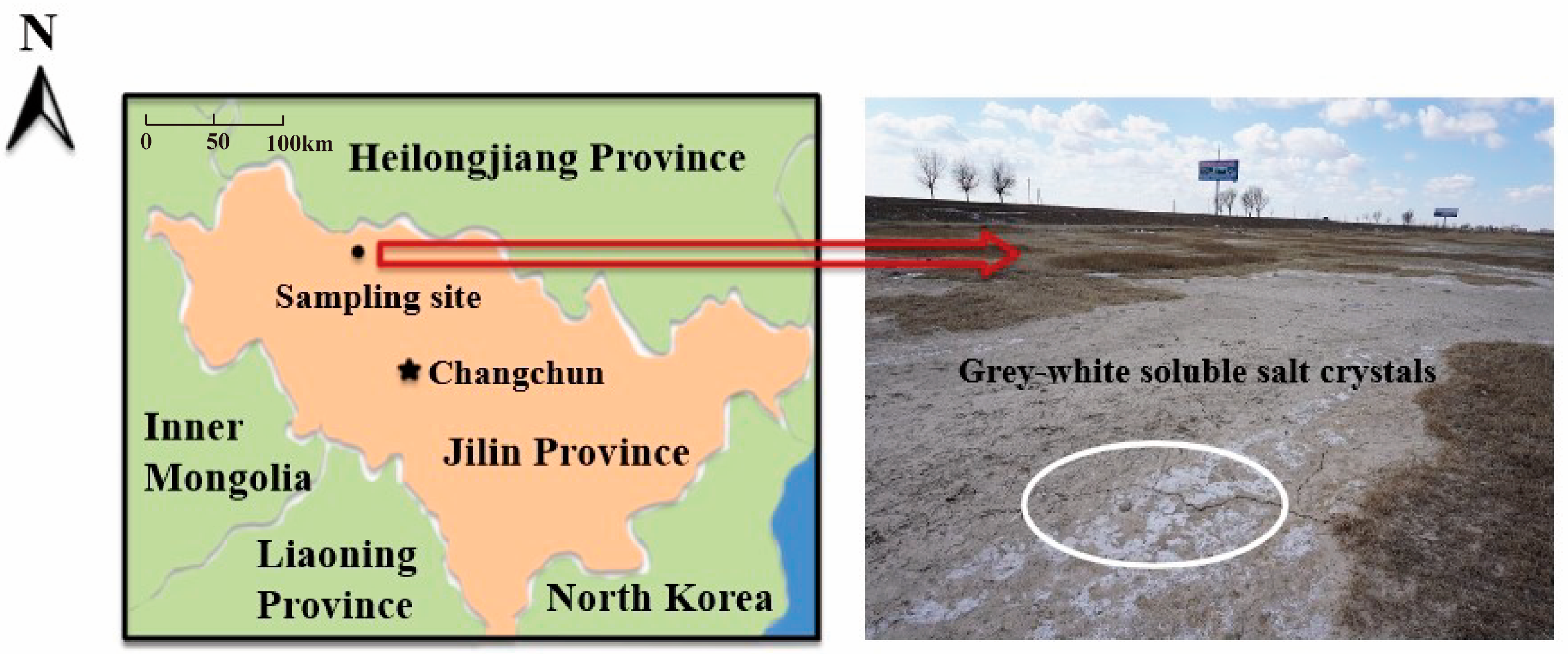
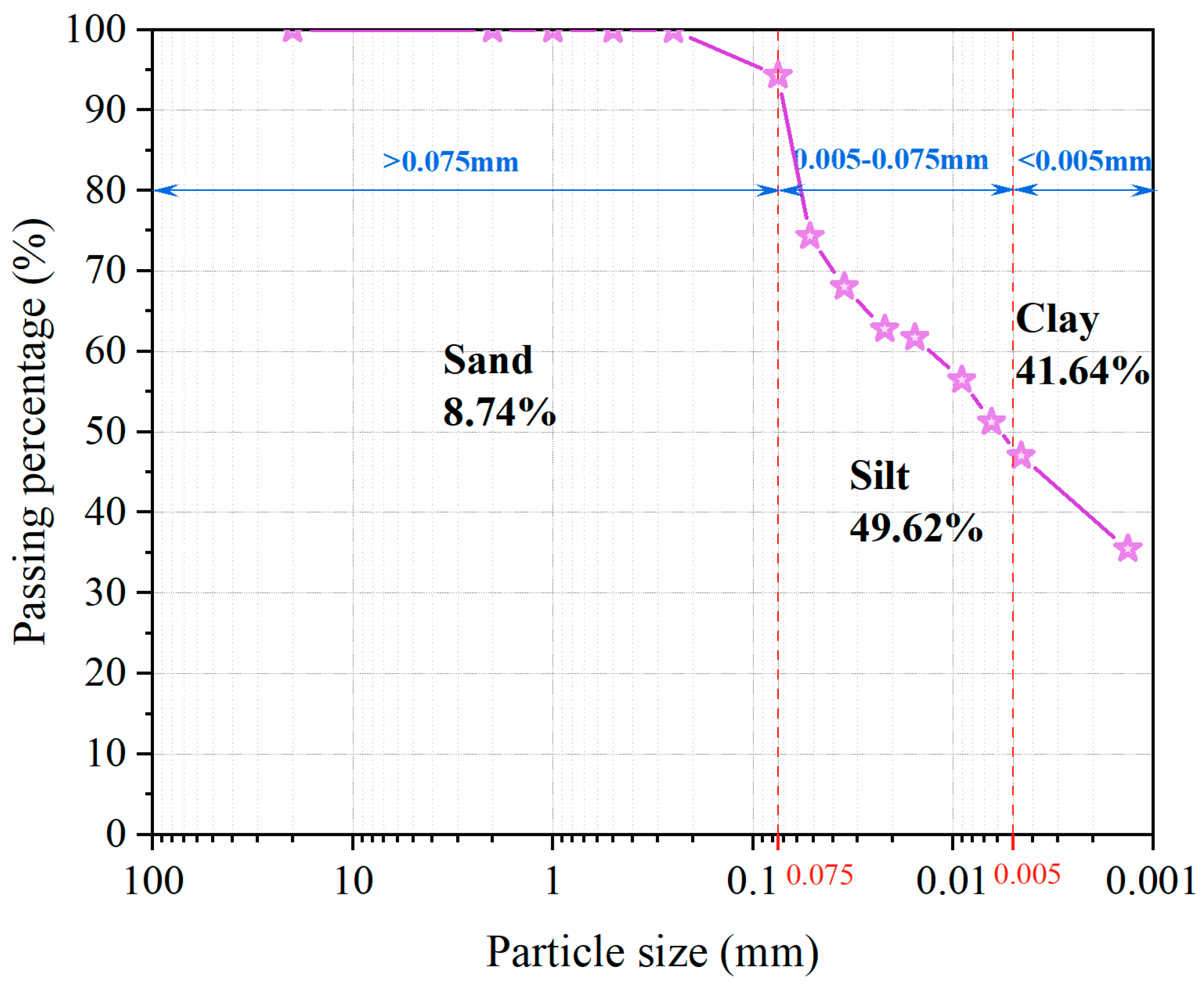


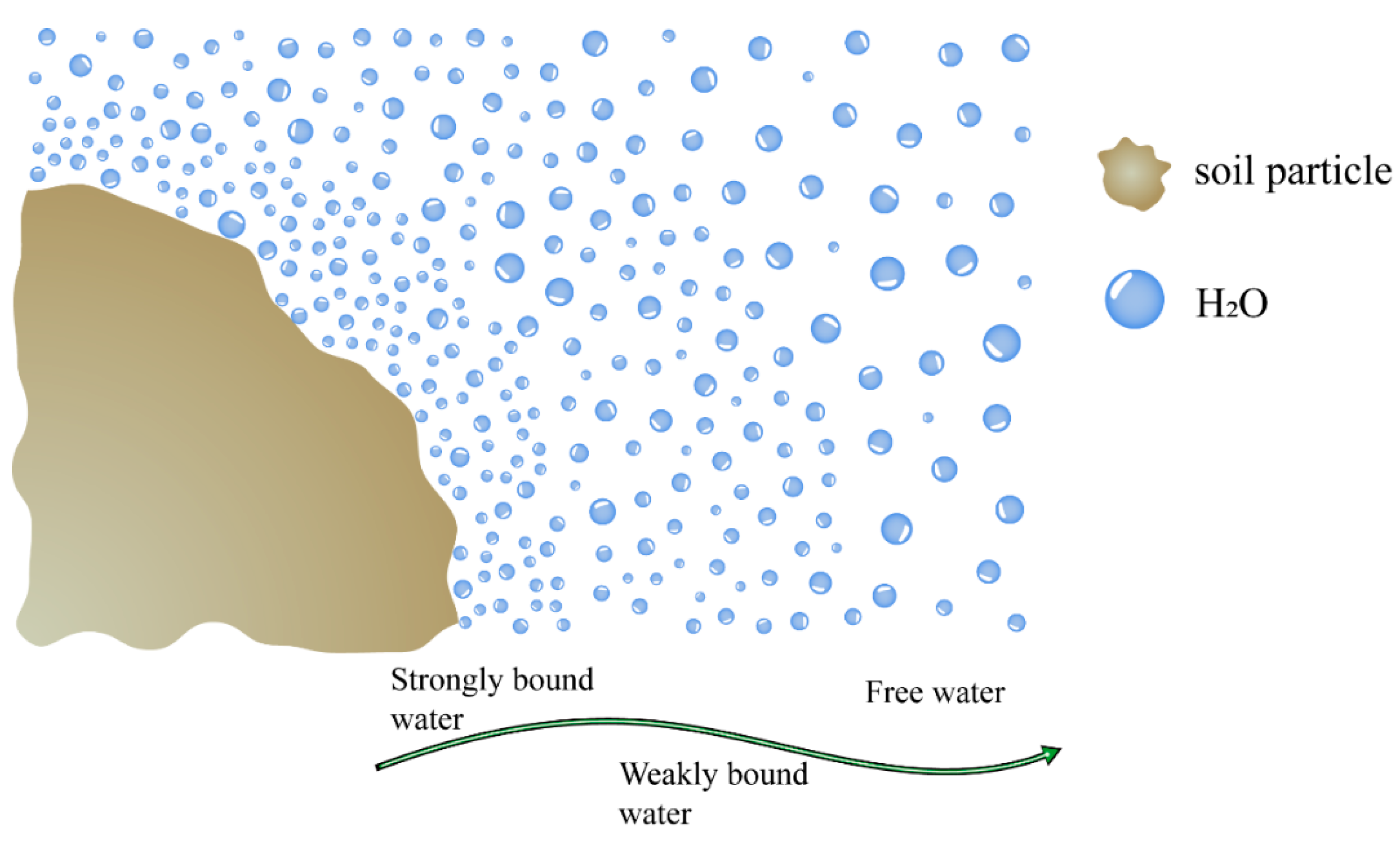
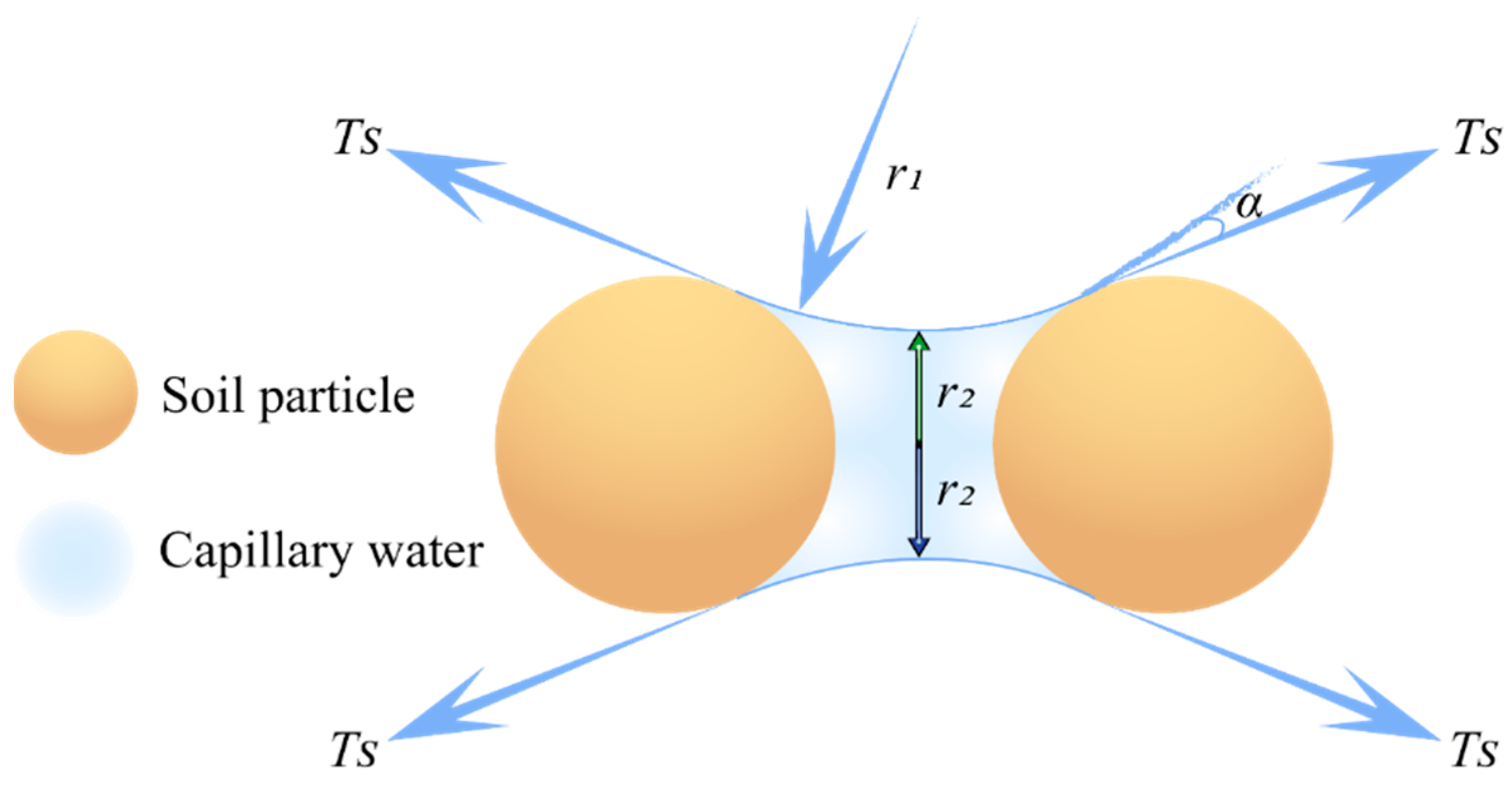
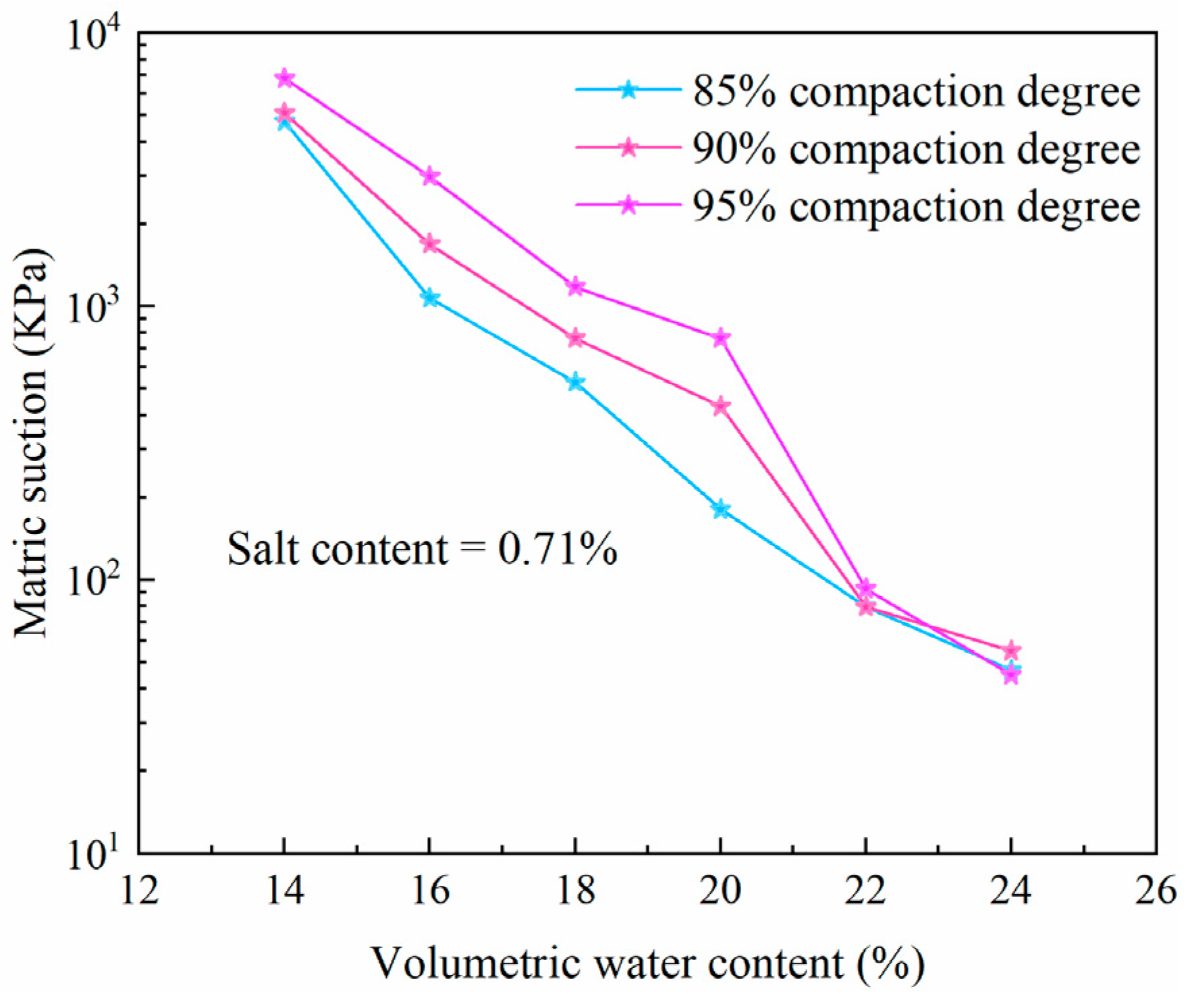


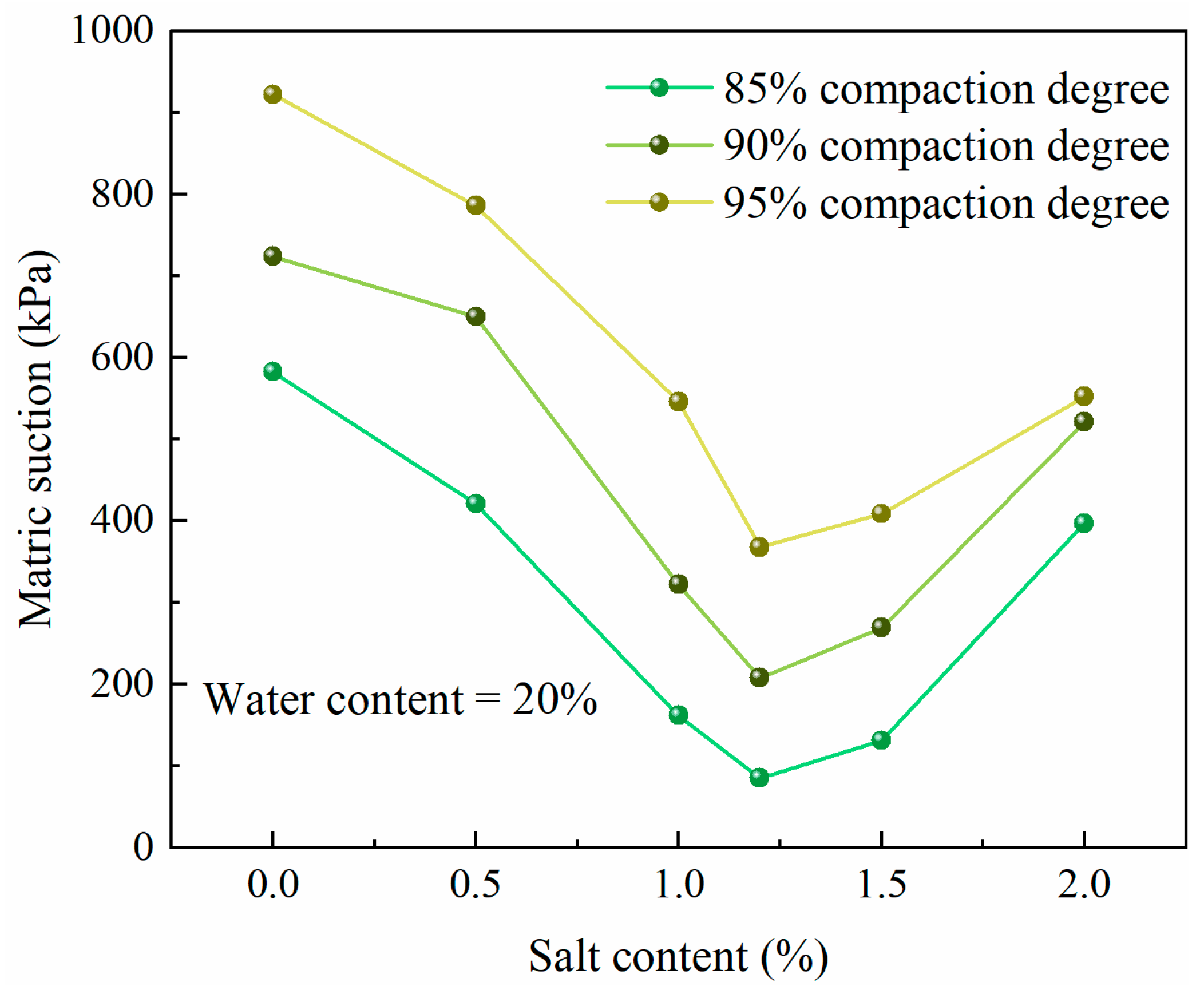

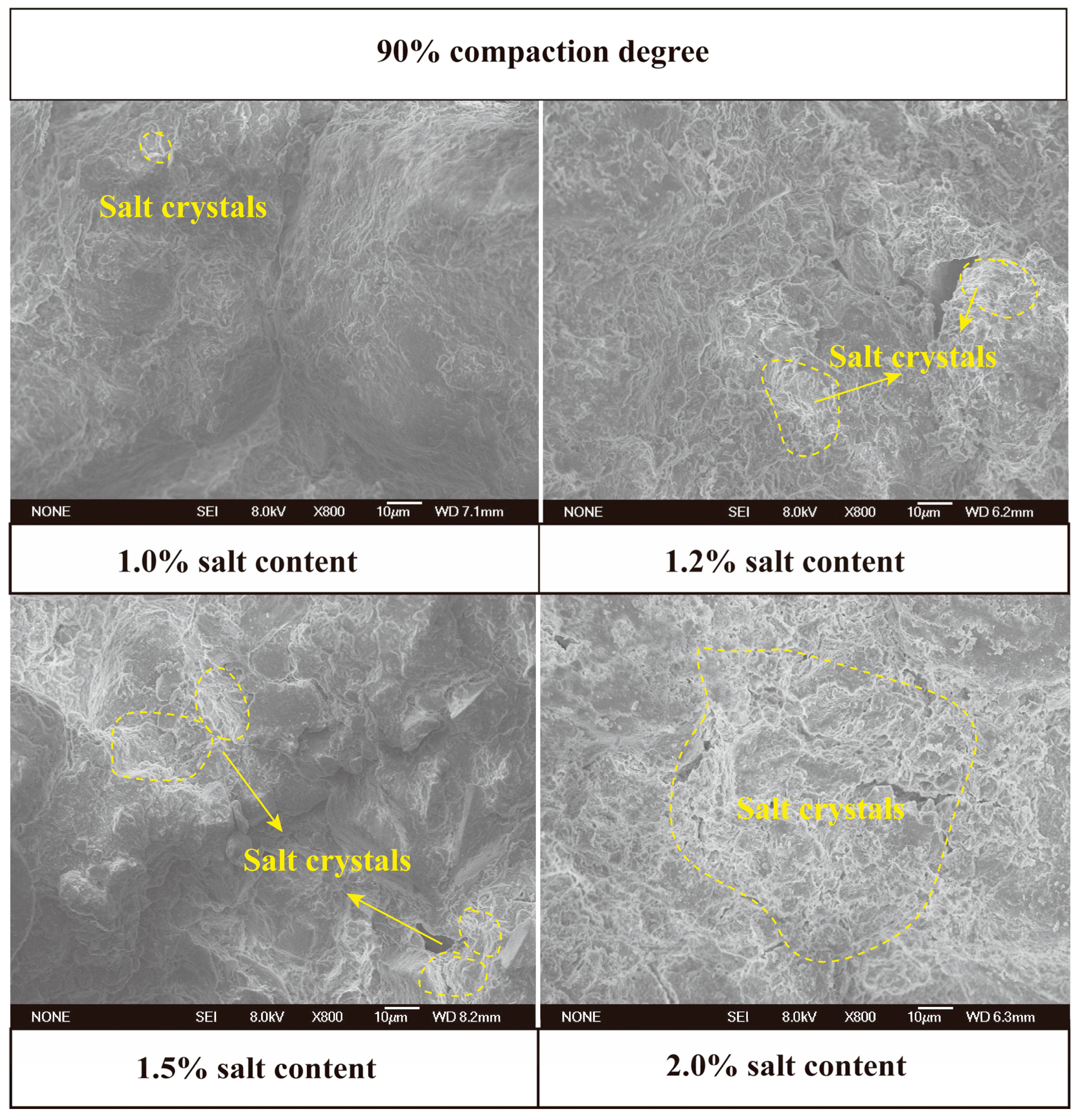
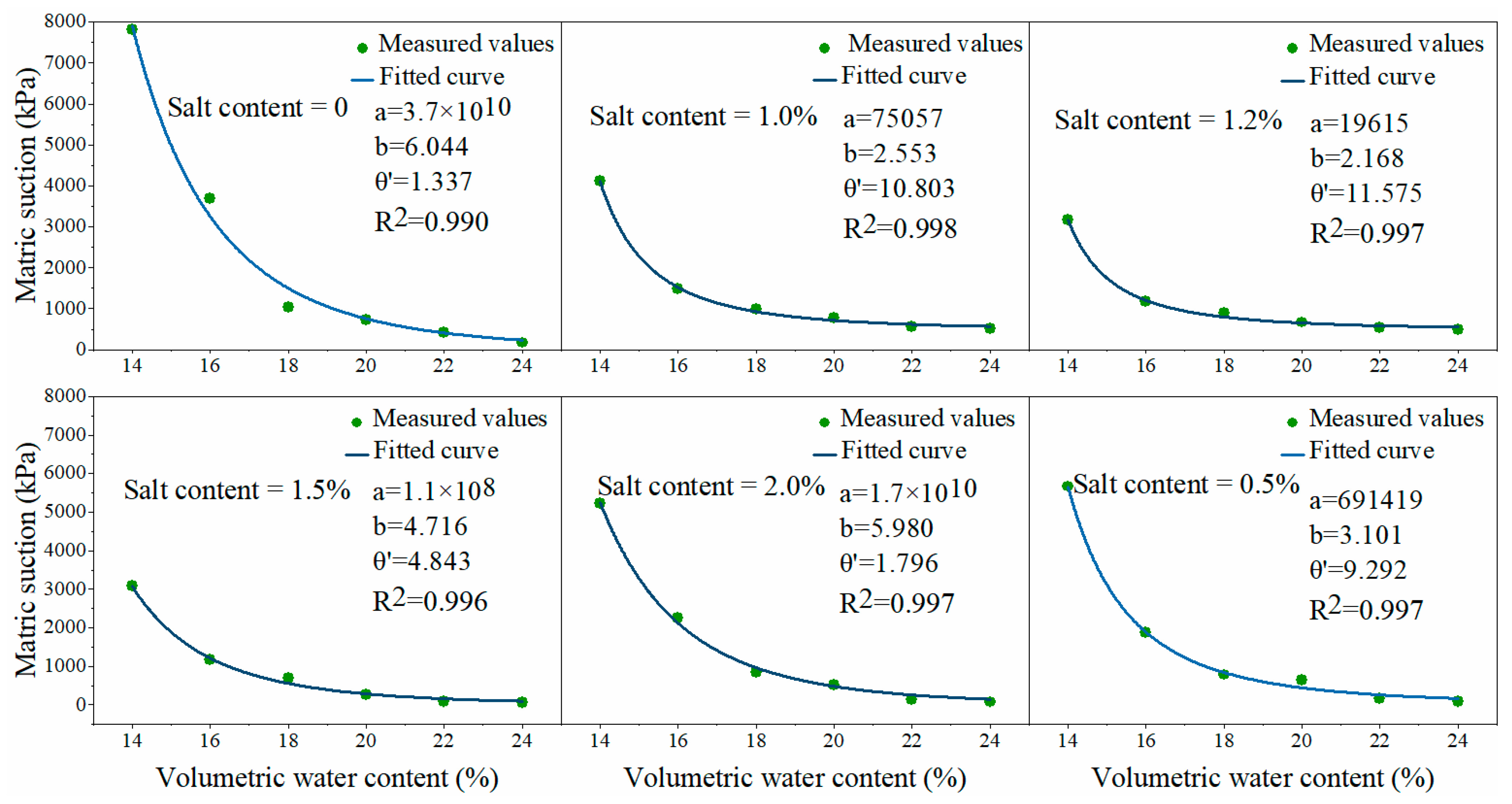
| Soil Type | Natural Water Content (%) | Maximum Dry Density (g/cm3) | Plastic Limit (%) | Liquid Limit (%) | Plastic Index | Specific Gravity |
|---|---|---|---|---|---|---|
| CL | 21.58 | 1.78 | 19.00 | 45.75 | 26.75 | 2.73 |
| Item | Total | Na+ | K+ | Ca2+ | Mg2+ | SO42− | HCO3− | CO32− | Cl− |
|---|---|---|---|---|---|---|---|---|---|
| Content (%) | 0.71 | 0.074 | 0.006 | 0.003 | 0.007 | 0.055 | 0.237 | 0 | 0.064 |
| Method | Water-bath evaporation | Flame photometer | EDTA complexometric titration | Neutralization titration | Silver nitrate titration | ||||
| Primary Minerals | Secondary Minerals | |
|---|---|---|
| Content (%) | 88% | 12% |
Disclaimer/Publisher’s Note: The statements, opinions and data contained in all publications are solely those of the individual author(s) and contributor(s) and not of MDPI and/or the editor(s). MDPI and/or the editor(s) disclaim responsibility for any injury to people or property resulting from any ideas, methods, instructions or products referred to in the content. |
© 2025 by the authors. Licensee MDPI, Basel, Switzerland. This article is an open access article distributed under the terms and conditions of the Creative Commons Attribution (CC BY) license (https://creativecommons.org/licenses/by/4.0/).
Share and Cite
Shan, X.; Chen, H.; Ma, B.; Yu, Q.; Wang, Z.; Wang, Q. Analysis of Factors and Mechanisms Influencing the Matric Suction and Water-Holding Capacity of Carbonate Saline Soil. Water 2025, 17, 469. https://doi.org/10.3390/w17040469
Shan X, Chen H, Ma B, Yu Q, Wang Z, Wang Q. Analysis of Factors and Mechanisms Influencing the Matric Suction and Water-Holding Capacity of Carbonate Saline Soil. Water. 2025; 17(4):469. https://doi.org/10.3390/w17040469
Chicago/Turabian StyleShan, Xuehan, Huie Chen, Bing Ma, Qingbo Yu, Zhaoxi Wang, and Qing Wang. 2025. "Analysis of Factors and Mechanisms Influencing the Matric Suction and Water-Holding Capacity of Carbonate Saline Soil" Water 17, no. 4: 469. https://doi.org/10.3390/w17040469
APA StyleShan, X., Chen, H., Ma, B., Yu, Q., Wang, Z., & Wang, Q. (2025). Analysis of Factors and Mechanisms Influencing the Matric Suction and Water-Holding Capacity of Carbonate Saline Soil. Water, 17(4), 469. https://doi.org/10.3390/w17040469








